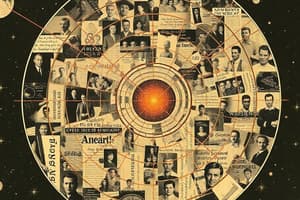Podcast
Questions and Answers
How does actual motion differ from apparent motion?
How does actual motion differ from apparent motion?
- Actual motion relies on visual perception, while apparent motion involves physical movement.
- There is no difference between actual and apparent motion; they both describe the same phenomenon.
- Actual motion describes the real movement of objects, whereas apparent motion describes how objects appear to move from a specific viewpoint. (correct)
- Actual motion is only applicable to celestial bodies, while apparent motion is applicable to objects on Earth.
What observation primarily led early astronomers to develop the geocentric model?
What observation primarily led early astronomers to develop the geocentric model?
- The apparent daily rising and setting of the sun and stars. (correct)
- The observed phases of the moon.
- The elliptical paths of comets.
- The consistent orbital speed of planets.
Which of the following best explains the shift from the geocentric to the heliocentric model?
Which of the following best explains the shift from the geocentric to the heliocentric model?
- The heliocentric model more accurately explained planetary movements and other astronomical phenomena. (correct)
- The geocentric model was only applicable to predicting lunar eclipses.
- There was no real shift; both models were used concurrently.
- The geocentric model became more accurate with technological advancements.
In what way does our current understanding refine the heliocentric model?
In what way does our current understanding refine the heliocentric model?
What is a key difference between the actual motion and the apparent motion of stars as observed from Earth?
What is a key difference between the actual motion and the apparent motion of stars as observed from Earth?
If an astronomer observes a planet moving in retrograde (backwards) motion, is this an example of actual or apparent motion?
If an astronomer observes a planet moving in retrograde (backwards) motion, is this an example of actual or apparent motion?
Which concept explains why the constellations appear to move across the night sky throughout the year?
Which concept explains why the constellations appear to move across the night sky throughout the year?
Given our current understanding of the universe, how would we describe the location of the 'center'?
Given our current understanding of the universe, how would we describe the location of the 'center'?
What underlying assumption was proven incorrect when the heliocentric model replaced the geocentric model?
What underlying assumption was proven incorrect when the heliocentric model replaced the geocentric model?
Why do we still use terms like 'sunrise' and 'sunset' when we know the sun isn't actually moving around the Earth?
Why do we still use terms like 'sunrise' and 'sunset' when we know the sun isn't actually moving around the Earth?
Flashcards
Actual Motion
Actual Motion
The real movement of an object.
Apparent Motion
Apparent Motion
How an object appears to move from an observer's perspective.
Geocentric Model
Geocentric Model
Earth is the center of the universe and everything revolves around it.
Heliocentric Model
Heliocentric Model
Signup and view all the flashcards
Sun's place
Sun's place
Signup and view all the flashcards
Study Notes
- Actual motion refers to the way objects are actually moving.
- Earth's rotation on its axis is an example of actual motion.
- Apparent motion refers to how objects appear to move.
- The rising and setting of the sun each day is an example of apparent motion, caused by Earth's rotation.
- Early astronomers created the geocentric model based on the apparent motion of the sun and stars.
- The geocentric model places Earth at the center of the universe.
- The heliocentric model replaced the geocentric model.
- The heliocentric model places the sun at the center of the universe.
- In reality, the sun sits at the center of our solar system only, not the entire universe.
Studying That Suits You
Use AI to generate personalized quizzes and flashcards to suit your learning preferences.



